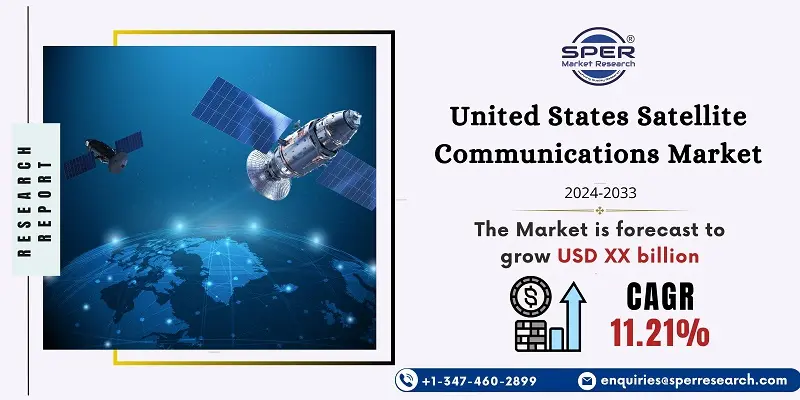
United States Satellite Communications Market Trends, Share, Size, Demand and Future Outlook
United States Satellite Communications Market Growth, Size, Trends Analysis- By Type, By Platform, By End User- Regional Outlook, Competitive Strategies and Segment Forecast to 2033
| Published: Oct-2024 | Report ID: IACT24178 | Pages: 1 - 108 | Formats*: |
| Category : Information & Communications Technology | |||
- January 2023; Global communications company Viasat Inc. announced that it has been awarded a contract to provide the USMC with end-to-end satellite communications through a fully managed solution. The agreement is a continuation of a fruitful pilot and follow-up service program in which Viasat provided the USMC I Marine Expeditionary Force with a fully managed SATCOM as a Managed Service solution.
- August 2022; It was reported that SpaceLink and the Defense Advanced Research Projects Agency will work together to develop standards for attaching commercial communications constellations to military and defense hardware. Earlier this month, DARPA announced a new project called Space BACN, which aims to build inexpensive optical lines to link government and private constellations.


| Report Metric | Details |
| Market size available for years | 2020-2033 |
| Base year considered | 2023 |
| Forecast period | 2024-2033 |
| Segments covered | By Type, By Platform, By End User. |
| Regions covered | Northeast, Midwest, South, West. |
| Companies Covered | Thales Group, Inmarsat Global Limited, Iridium Communications Inc, Gilat Satellite Networks Ltd, Orbcomm Inc, Cobham Satcom (Cobham Limited), Viasat Inc, L3Harris Technologies Inc, KVH Industries Inc, Spire Global Inc. |
- Government and Defense Agencies
- Maritime and Aviation Industries
- Telecommunication Companies
- Media and Broadcasting Companies
- Energy and Utilities Sector
- Enterprise and Corporate Sector
- Healthcare and Emergency Services
- Transportation and Logistics Companies
- Internet Service Providers (ISPs)
| By Type: | |
| By Platform: | |
| By End-User: |
- United States Satellite Communications Market Size (FY’2024-FY’2033)
- Overview of United States Satellite Communications Market
- Segmentation of United States Satellite Communications Market By Type (Ground Equipment, Services)
- Segmentation of United States Satellite Communications Market by Platform (Portable, Land, Maritime, Airborne)
- Segmentation of United States Satellite Communications Market By End-User (Maritime, Defense and Government, Enterprises, Media and Entertainment)
- Statistical Snap of United States Satellite Communications Market
- Expansion Analysis of United States Satellite Communications Market
- Problems and Obstacles in United States Satellite Communications Market
- Competitive Landscape in the United States Satellite Communications Market
- Impact of COVID-19 and Demonetization on United States Satellite Communications Market
- Details on Current Investment in United States Satellite Communications Market
- Competitive Analysis of United States Satellite Communications Market
- Prominent Players in the United States Satellite Communications Market
- SWOT Analysis of United States Satellite Communications Market
- United States Satellite Communications Market Future Outlook and Projections (FY’2024-FY’2033)
- Recommendations from Analyst
1.1. Scope of the report1.2. Market segment analysis
2.1. Research data source
2.1.1. Secondary Data2.1.2. Primary Data2.1.3. SPERs internal database2.1.4. Premium insight from KOLs
2.2. Market size estimation
2.2.1. Top-down and Bottom-up approach
2.3. Data triangulation
4.1. Driver, Restraint, Opportunity and Challenges analysis
4.1.1. Drivers4.1.2. Restraints4.1.3. Opportunities4.1.4. Challenges
4.2. COVID-19 Impacts of the United States Satellite Communications Market
5.1. SWOT Analysis
5.1.1. Strengths5.1.2. Weaknesses5.1.3. Opportunities5.1.4. Threats
5.2. PESTEL Analysis
5.2.1. Political Landscape5.2.2. Economic Landscape5.2.3. Social Landscape5.2.4. Technological Landscape5.2.5. Environmental Landscape5.2.6. Legal Landscape
5.3. PORTERs Five Forces
5.3.1. Bargaining power of suppliers5.3.2. Bargaining power of buyers5.3.3. Threat of Substitute5.3.4. Threat of new entrant5.3.5. Competitive rivalry
5.4. Heat Map Analysis
6.1. United States Satellite Communications Market Manufacturing Base Distribution, Sales Area, Product Type6.2. Mergers & Acquisitions, Partnerships, Product Launch, and Collaboration in United States Satellite Communications Market
7.1. United States Satellite Communications Market Size, Share and Forecast, By Type, 2020-20267.2. United States Satellite Communications Market Size, Share and Forecast, By Type, 2027-20337.3. Ground Equipment7.4. Services
8.1. United States Satellite Communications Market Size, Share and Forecast, By Platform, 2020-20268.2. United States Satellite Communications Market Size, Share and Forecast, By Platform, 2027-20338.3. Portable8.4. Land8.5. Maritime8.6. Airborne
9.1. United States Satellite Communications Market Size, Share and Forecast, By End-User, 2020-20269.2. United States Satellite Communications Market Size, Share and Forecast, By End-User, 2027-20339.3. Maritime9.4. Defense and Government9.5. Enterprises9.6. Media and Entertainment
10.1. United States Satellite Communications Market Size and Market Share By Region (2020-2026)10.2. United States Satellite Communications Market Size and Market Share By Region (2027-2033)10.3. Northeast10.4. Midwest10.5. South10.6. West
11.1. Thales Group
11.1.1. Company details11.1.2. Financial outlook11.1.3. Product summary11.1.4. Recent developments
11.2. Inmarsat Global Limited
11.2.1. Company details11.2.2. Financial outlook11.2.3. Product summary11.2.4. Recent developments
11.3. Iridium Communications Inc
11.3.1. Company details11.3.2. Financial outlook11.3.3. Product summary11.3.4. Recent developments
11.4. Gilat Satellite Networks Ltd
11.4.1. Company details11.4.2. Financial outlook11.4.3. Product summary11.4.4. Recent developments
11.5. Orbcomm Inc
11.5.1. Company details11.5.2. Financial outlook11.5.3. Product summary11.5.4. Recent developments
11.6. Cobham Satcom (Cobham Limited)
11.6.1. Company details11.6.2. Financial outlook11.6.3. Product summary11.6.4. Recent developments
11.7. Viasat Inc
11.7.1. Company details11.7.2. Financial outlook11.7.3. Product summary11.7.4. Recent developments
11.8. L3Harris Technologies Inc
11.8.1. Company details11.8.2. Financial outlook11.8.3. Product summary11.8.4. Recent developments
11.9. KVH Industries Inc
11.9.1. Company details11.9.2. Financial outlook11.9.3. Product summary11.9.4. Recent developments
11.10. Spire Global Inc.
11.10.1. Company details11.10.2. Financial outlook11.10.3. Product summary11.10.4. Recent developments
11.11. Others
SPER Market Research’s methodology uses great emphasis on primary research to ensure that the market intelligence insights are up to date, reliable and accurate. Primary interviews are done with players involved in each phase of a supply chain to analyze the market forecasting. The secondary research method is used to help you fully understand how the future markets and the spending patterns look likes.
The report is based on in-depth qualitative and quantitative analysis of the Product Market. The quantitative analysis involves the application of various projection and sampling techniques. The qualitative analysis involves primary interviews, surveys, and vendor briefings. The data gathered as a result of these processes are validated through experts opinion. Our research methodology entails an ideal mixture of primary and secondary initiatives.



Frequently Asked Questions About This Report
PLACE AN ORDER
Year End Discount
Sample Report
Pre-Purchase Inquiry
NEED CUSTOMIZATION?
Request CustomizationCALL OR EMAIL US
100% Secure Payment






Related Reports
Our Global Clients
Our data-driven insights have influenced the strategy of 200+ reputed companies across the globe.






















